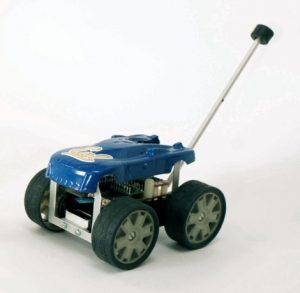Have you ever wondered why certain animals have tails? Did you ever think that a robot might need a tail as well?
Many disciplines of Science stress on the importance of observing the nature. Biomimetics, the process of imitating nature, can also be applied to the field of robotics. And so, the idea of a robotic tail was born. In fact, a robotic tail can be used to adjust the inertia of a mobile robot which in turn can enhance the robot’s stability and maneuverability. In reality, a reaction wheel can also be used to adjust the robot’s inertia. But, according to the research article prepared by Briggs et al. , a robotic tail can provide a greater moment of inertia than a reaction wheel within a given amount of space and time. Thus it safe to say that robotic tails are more appropriate for mobile robots.
 picture courtesy: Daniel Koditschek
picture courtesy: Daniel Koditschek
The following video demonstrates how the MIT cheetah robot maintains stability with the help of a tail when hit by a ball. Note that the left frame of the video shows the cheetah with a fixed tail whereas the right frame of the video shows the cheetah with a movable tail.
video credit: Biomimetics MIT
The MIT cheetah used a pendulum like tail. While it does enhance the balancing of the robot, the tail itself is quite rigid. It does not provide the complete movement that a tail would require to maneuver through its surroundings.
We need a tail that is more flexible. And this is where soft robotics, a relatively new subfield of robotics, comes in. With the help of soft robotics, flexible soft structures can be designed that are more identical to their biological counterparts, both by looks and by functionality.
The following video demonstrates an application of soft robotics. The robotic fish shown in the video uses a flexible tail(also known as a continuum tail). A continuum tail facilitates the necessary bending that the tail requires to help the
fish easily navigate through its surroundings.
video credit: MITCSAIL
It is safe to say that a robotic tail has the capability to increase a mobile robot’s performance by enhancing it’s maneuverability and stability. By observing biological species more closely, scientists have shown advancements in technology through the implementation of more sophisticated tail mechanisms that also mimic these species more meticulously. Robotic tails is just one of the many applications of biomimetics. This game of mimicry has the potential to make a major breakthrough in the field of science. In fact, Thomas Friedman, a Pulitzer Prize-winning author, said “The countries, communities, and companies that most closely [and] consciously mirror Mother Nature … are the ones that are going to thrive in what I call the Age of Accelerations. I’m a big believer in biomimicry.”
